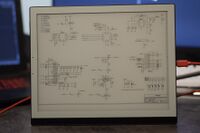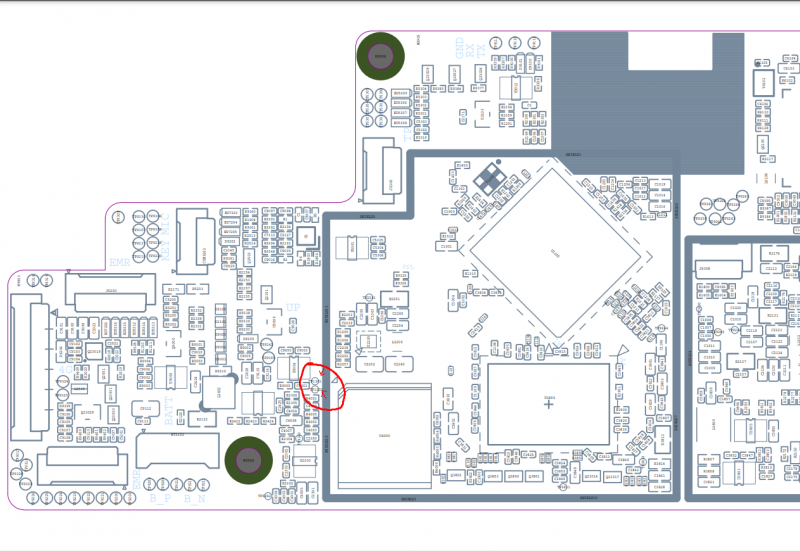PINE64 PineNote (pine64-pinenote)
 The PineNote showing a pdf | |
| Manufacturer | PINE64 |
|---|---|
| Name | PineNote |
| Codename | pine64-pinenote |
| Released | 2021 |
| Type | ebook reader |
| Hardware | |
| Chipset | Rockchip RK3566 |
| CPU | 4x 2Ghz Cortex-A55 |
| GPU | Mali G52 2EEUsing ebook reader hardware |
| Display | 1404x1872 e-paper |
| Storage | 128 GB |
| Memory | 4GB |
| Architecture | aarch64 |
| Software | |
Original software The software and version the device was shipped with. |
Debian 13 |
Extended version The most recent supported version from the manufacturer. |
Debian |
| postmarketOS | |
| Category | testing |
Mainline Instead of a Linux kernel fork, it is possible to run (Close to) Mainline. |
yes |
| Device package |
|
| Kernel package |
|
Flashing Whether it is possible to flash the device with pmbootstrap flasher. |
Works
|
|---|---|
USB Networking After connecting the device with USB to your PC, you can connect to it via telnet (initramfs) or SSH (booted system). |
Broken
|
Battery Whether charging and battery level reporting work. |
Works
|
Screen Whether the display works; ideally with sleep mode and brightness control. |
Works
|
Touchscreen |
Works
|
| Multimedia | |
3D Acceleration |
Works
|
Audio Audio playback, microphone, headset and buttons. |
Works
|
| Connectivity | |
WiFi |
Works
|
Bluetooth |
Works
|
| Miscellaneous | |
FDE Full disk encryption and unlocking with unl0kr. |
Broken
|
USB OTG USB On-The-Go or USB-C Role switching. |
Works
|
| Sensors | |
Accelerometer Handles automatic screen rotation in many interfaces. |
Works
|
| This device is based on the Rockchip RK3566. See the SoC page for common tips, guides and troubleshooting steps |
The PineNote is a 10.3" e-ink tablet produced by Pine64 for the Linux mobile community. For information on optimizing application for e-ink displays, please go to this page.
Installation
The latest Community edition of the PineNote ships with a Debian image that is setup for dual-booting, while the Developer edition shipped with Android. If you still have Android on your device, these steps will not work. Please refer to PNDeb's guide to upgrade your PineNote to the Community edition.
Build image
First, lets build the postmarketOS image with pmbootstrap. Currently, only Sway has been optimized for this device. Support for Gnome, based on the stock configuration, is in the works. Depending on the configuration, you may need to add some extra space to the initial rootfs.
$ pmbootstrap init # pine64 pinenote
$ pmbootstrap install
Boot rockusb mode
The device is only flashable using the rkusb bootloader mode. This can be done with the opensource rkdeveloptool utility avilable on Alpine's testing branch or from https://gitlab.com/pine64-org/quartz-bsp/rkdeveloptool.
To trigger the bootloader hold a magnet near the top right of the back of the device of the pinenote while powering it. There is a small circle printed on the back cover indicating the correct location for the magnet.
When it's booted correctly into bootloader mode it should show up in the device list of rkdeveloptool:
$ rkdeveloptool ld
DevNo=1 Vid=0x2207,Pid=0x350a,LocationID=100 Loader
As the standard SPL does not have all the necessary commands, we have to boot into Rockchip's proprietary SPL. As it is packaged by the device's u-boot package, it is already available in the installation's chroot:
$ rkdeveloptool reboot-maskrom
$ rkdeveloptool boot ~/.local/share/pmbootstrap/chroot_rootfs_pine64-pinenote/usr/share/u-boot/pine64-pinenote/rk356x_spl_loader_v1.12.112.bin
Backup important partitions
The device includes some important firmare blobs on its storage, which we should backup. While this installation process does not touch these partitions, these blobs are unique to each device, and should be kept safe.
$ rkdeveloptool read 0 41943040 first_40mb_of_disc.img
$ rkdeveloptool read-partition waveform part_waveform.img
Repartition storage
We need then to repartition the storage, as there isn't by default a seperate kernel partition. The partition table is set by a seperate partition-table.txt file and must contain:
mtdparts=rk3566mmc:0x3FC0@0x40(idbloader),0x20000@0x4000(uboot),0x1000@0x24000(waveform),0x800@0x25000(uboot_env),0x20000@0x25800(logo),0x85800@0x45800(boot:bootable),-@0xcb000(os1:grow)With this file we can flash the new partition table:
$ rkdeveloptool write-partition-table partition_table.txt
Flash the images
After this step, we are ready to flash the system by starting with the u-boot:
$ rkdeveloptool write-partition idbloader ~/.local/share/pmbootstrap/chroot_rootfs_pine64-pinenote/usr/share/u-boot/pine64-pinenote/idbloader.img
$ rkdeveloptool write-partition uboot ~/.local/share/pmbootstrap/chroot_rootfs_pine64-pinenote/usr/share/u-boot/pine64-pinenote/u-boot.itb
And then the actual system partitions. You may need to to reset the device between flashing the rootfs and kernel and putting it back into rockusb mode.
$ pmbootstrap flasher flash_rootfs
$ pmbootstrap flasher flash_kernel
Run pmbootstrap shutdown to exit out of pmbootstrap, and reboot via long-pressing the power button. The first boot will take a few moments as the system is first setup.
Contributors
- MartijnBraam
- Petr Hodina
- Casey Connolly
- Antoine Martin (ayakael)
Users owning this device
- Aa13q
- AlleM43
- Antonroots
- Ayakael (Notes: Bringing-up SXMO, port maintainer)
- Icenowy
- Jan64X
- Kcxt (Notes: Worked on mainline bringup)
- MartijnBraam
Recover from a broken bootloader
If uboot image is overwritten the rockusb mode won't work anymore. The device might boot into maskrom mode in which case it should show up in `rkdeveloptool list` as maskrom. If the uboot image is partially overwritten but still recognized by the maskrom it won't stay in maskrom mode and you'd have to open the back of the device and short TP1301 and TP1302 while powering up. This will make eMMC reads fail so maskrom always runs.
Once the device is in maskrom mode the only thing you can do is push a new loader into ram and start that.
$ rkdeveloptool list
here it lists maskrom now
The .bin file is build by u-boot and might have a slightly different version
$ rkdeveloptool db rk356x_spl_loader_v1.04.108.bin
$ rkdeveloptool ptt
now it's able to read flash and list the partitions
Waveform
There exists a GNOME Shell extension for selecting the waveform for the panel. The waveform affects the quality and speed of the refresh. Different waveforms
You can also adjust waveform settings using sysfs parameters under /sys/module/rockchip_ebc/parameters
| Parameter | Function | Possible values |
|---|---|---|
| bw_mode | Sets black and white mode of display | 0: grayscale, 1: bw + dithering, 2: bw, 3: DU4 waveform |
| bw_threshold | Sets threshold where pixel is considered white or black. If default, all pixel values lower than 7 will be cast to 0 (left), and all values larger larger or equivalent will be cat to 15 (white) | 0-15, 7 is default |
| auto_refresh | Global refreshes are triggered based on the area drawing using partial refreshes, in units of total screen area. | 0: enabled, 1: disabled (default) |
| refresh_threshold | Global refreshes are triggered based on the area drawing using partial refreshes, in units of total screen area. | 20 is default |
| refresh_waveform | Sets the waveform to use for global refreshes. | 4 is default |
| dclk_select | Controls how fast data is sent to the ebc display, allowing for a "quality" mode that reduces visible artifacts as much as possible, with the downside of having bad latency, and a "performance" mode where speed is gained at the expense of visual quality. | 0: quality mode (default), 1: performance mode |
dclk_select changes should also be accompanied with a display mode change. On the debian image, "quality" mode is associated with a 5hz refresh rate, while "performance" is 80hz.
The following command, after installing pinenote-dbus-service and starting the pinenote service, can force a refresh of the screen:
$ dbus-send --system --print-reply --dest=org.pinenote.ebc /ebc org.pinenote.ebc.TriggerGlobalRefresh
See also
- PINE64 wiki page
- fork of rkdeveloptool with many improvements this will be the version supported on the pinenote.
- pmbootstrap!2165 - support for rkdeveloptool in pmbootstrap for flashing with BSP u-boot
- pmaports!2910, pmaports!3778 - MR for initial device support
- pmaports!4142 - MR for configuring the waveform for the panel
- Guides on modify uboot boot behavior
- Notes by m-weigand on EBC parameters
- pinenote-gnome-extension source code with more info on EBC
